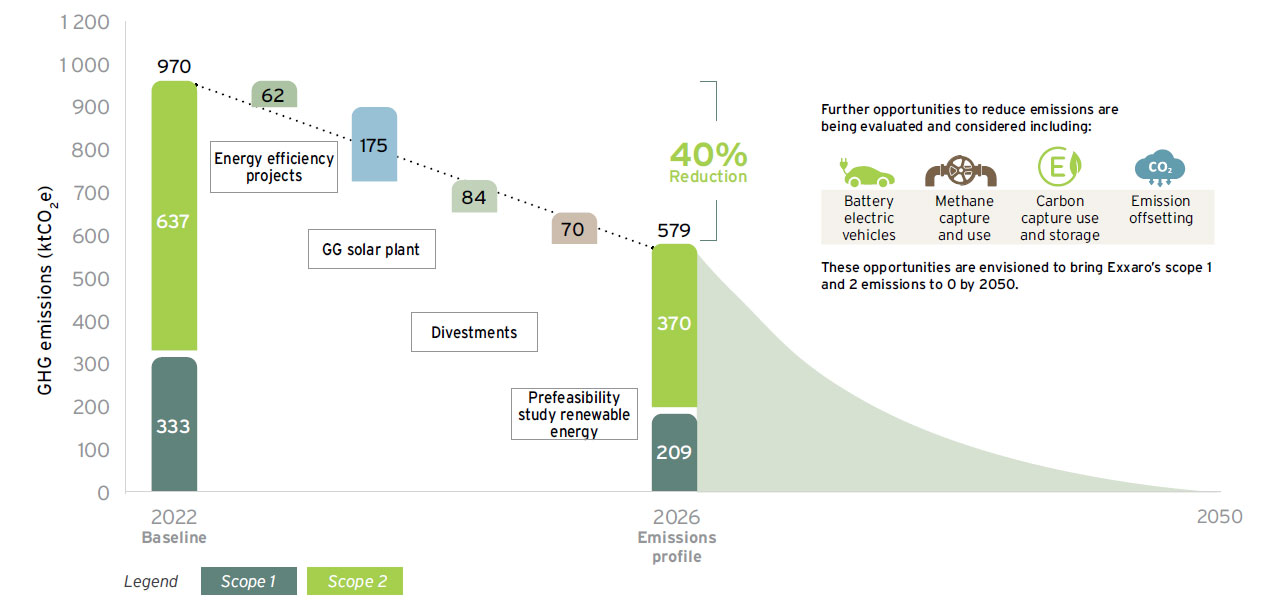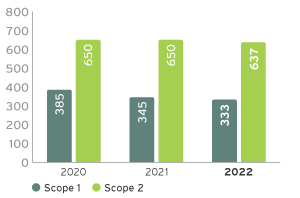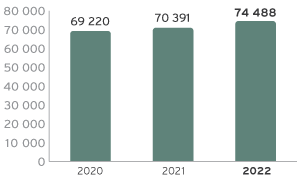Exxaro's response to climate change emphasises the sustainability imperative through environmental, social, financial and legislative aspects. Our strategic objectives support our efforts to contribute to a just transition. Delivering on this requires a systemic and institutional approach, with all aspects of our business involved in this transition.
Our TCFD disclosure is embedded throughout our reporting suite and our online publications. ![]() TCFD index
TCFD index
Two of Exxaro's strategic objectives – to transition at speed and scale and to be carbon neutral by 2050 – outline our goals and commitment to fundamentally change our business to positively respond to the climate change agenda. Our Climate Change Response strategy, decarbonisation plan, alignment with TCFD recommendations and linked STI scheme across the business support the achievement of these objectives. The STI scheme incentivises carbon and energy reductions across the group. The principles and mechanisms to respond to climate change are integrated throughout our business, and are central to our thinking and actions.
We mitigate climate change and its impacts through:
| Climate Change Response strategy and decarbonisation plan |
Carbon emissions reductions are driven by our efforts in energy management and the implementation of cleaner energy sources at our operations. South Africa has revised its nationally determined contribution (NDC) target range for 2025 to 398MtCO2e to 510MtCO2e and for 2030 to 350MtCO2e to 420MtCO2e compared to 398MtCO2e to 614MtCO2e between 2025 and 2030 as communicated in the first NDC. The revised NDC requires us to do more to support the country's transition to a low-carbon economy
To ensure comparability, Exxaro measures, manages and reports energy and carbon data in terms of the GHG Protocol's Corporate Accounting and Reporting Standard. Our scope 1, 2 and 3 emissions are monitored and reported annually.
| Scope 1 | Direct GHG emissions (measured in tCO2e) from sources owned or controlled by Exxaro using diesel, petrol, gas, explosives and limestone. Production-related fugitive methane emissions are also included. |
| Scope 2 | GHG emissions from electricity generated by utility Eskom and purchased by Exxaro |
| Scope 3 | Emissions outside our control but emanating from our products or value chain activities such as customers burning coal supplied by Exxaro |
| GHG emissions recorded over the past three financial years |
| Internal performance measures | External performance measures |
|
|
In the 2022 CDP climate report, Exxaro is ranked in the management category (B score), which is higher than the coal mining sector average of C.
| For more information on our CDP performance, please refer to www.cdp.net and the databook. |
Promulgation of South Africa's Carbon Tax Act, 2019 (Act 15 of 2019) contributed to GHG emissions reduction being a business imperative as this could affect our financial and sustainability performance.
Governed by the Carbon Tax Act, the current carbon tax rate is R144/tCO2e with several tax-free allowances. Exxaro's carbon tax liability for 2022 was R2.6 million for production-related emissions, ie fugitive methane emissions associated with the coal seam.
The RBR committee manages climate change risks and opportunities. The SERC ensures we align with just transition principles. The ESG steering committee's role is to support Exxaro's ongoing commitment to environmental, health and safety, corporate social responsibility, corporate governance, sustainability, and other relevant public policy matters.
Current decarbonisation initiatives
Our decarbonisation plan includes a range of projects to reduce our emissions. These include self-generation solar PV projects and ongoing operational efficiency programmes, primarily focused on reducing diesel and electricity consumption. While it is critical to reduce our direct emissions, we are also focusing on reducing our indirect emissions. The largest contributor to our indirect emissions profile is our scope 3 emissions. It is also imperative for our stakeholders to understand the impact and importance of climate change mitigation, adaptation, and resilience. We have several ongoing educational and awareness initiatives with stakeholders across our value chain. While the impact of these initiatives cannot be measured in terms of tCO2e saved, they are critical to ensuring that we take everyone along with us on our journey and that our transition is just. We have already seen changes in behaviour by our employees, with increasing interest in reducing their personal carbon footprints.
| Low |
|
||||||||||||
| Scope 1 | Scope 2 | Scope 3 | Carbon credits | Enablers | |||||||||
Feasibility on green energy potential at operations |
Solar PV at Tshikondeni |
We are engaging strategically and taking targeted measures with our key suppliers with the view of partnering and collaborating on value chain emissions reduction Our approach of aligning our portfolio towards low-carbon transition minerals will be key in dealing with scope 3 emissions We are supporting industry and government efforts of developing low carbon technologies such as carbon capture and storage, which are critical for the removal of carbon emissions |
Community waste management/SLP |
Exxaro decarbonisation training and employee participation |
|||||||||
Energy and water efficiency programmes (linked to performance incentives) |
Solar PV at Solar PV at |
Land management projects |
Decarbonisation and communication plan |
||||||||||
Compliance focus: pollution prevention plans for operations |
Renewable energy consumption in all our operations | Rehabilitation opportunities |
Leadership-driven process |
||||||||||
Roadmap to become carbon neutral

| 2018 |
| Carbon intensity baseline assessment boundary for operational BUs and not mines in closure |
| 2020 |
|
| 2021 |
|
| 2022 |
|
| 2026 |
| Actively reduce scope 1 and 2 emissions by at least 40% through energy efficiency projects, self-generation and consumption of renewable energy at our operations and potential divestment. We will also continue working with our value chain partners to reduce scope 3 emissions and contribute to implementation of renewable energy projects by our value chain partners. |
| 2050 |
| Carbon neutral for scope 1 and 2 emissions. Our objective is to also contribute to carbon neutral value chains. |
As our decarbonisation journey moved into implementation, we included climate change metrics in scorecards across the business and
finalised our ![]() capital allocation model (integrated report), supported by analytics tools that informed strategic decision making. These tools enabled incremental steps towards emissions reductions against significant logistics constraints for our vehicle fleet, at our Grootegeluk operation. We addressed these constraints by implementing optimisation solutions that rectified higher carbon intensity per tonne of product mined due to sub-optimal equipment use. The optimisation solutions include:
capital allocation model (integrated report), supported by analytics tools that informed strategic decision making. These tools enabled incremental steps towards emissions reductions against significant logistics constraints for our vehicle fleet, at our Grootegeluk operation. We addressed these constraints by implementing optimisation solutions that rectified higher carbon intensity per tonne of product mined due to sub-optimal equipment use. The optimisation solutions include:
Total carbon intensity was 5.54tCO2e/kTTM (2021: 5.51tCO2e/kTTM) with scope 1* at 1.90tCO2e/kTTMRA (2021: 1.91tCO2e/kTTM) and scope 2* at 3.64tCO2e/kTTMRA (2021: 3.6tCO2e/kTTM). This translates to a 0.5% increase in carbon intensity due to the ramp-up of operations at Grootegeluk plant 6. Based on production tonnages in 2022, electricity intensity increased by 3.9% to 3.37MWh/kt (2021: 3.24MWh/kt) and diesel intensity decreased by 7% to 4.88MWh/kt (2021: 5.25MWh/kt). While our intensity increased, absolute GHG emissions decreased.
* All of Exxaro's BUs' carbon emissions are taken into account for these two intensity calculations.
| GHG emissions (ktCO2e) | Year-on-year change (%) |
2022 | Year-on-year change (%) |
2021 | Year-on-year change (%) |
2020 (baseline) |
|
| Target: Actual for previous year less 5% | Scope 1 | 333 | |
345 | 385 | ||
| Scope 21 | 637 | 650 | 650 | ||||
| Total scope 1 and 2 | 971 | 995 | 1 035 | ||||
| Scope 32 | 74 488RA | 70 931 | 69 220 |
| 1 | Scope 2: Electricity-based emissions are derived from the grid emission factor for South Africa, which is 1.08tCO2e per MWh. |
| 2 | Scope 3: Reported emissions based on the use of product sold by Exxaro (representing over 98% of Exxaro's scope 3 emissions). |
Exxaro has several operational efficiency programmes that aim to reduce scope 1 and 2 (direct) emissions by 62ktCO2e. These programmes focus on reducing diesel consumption. The solar PV project at Grootegeluk is designed to reduce emissions by 175ktCO2e upon commissioning.
Scope 1 and 2 GHG emissions (ktCO2e)

Scope 3 GHG emissions (ktCO2e)

| Carbon emissions by source(ktCO2e) | Year-on-year change (%) |
2022 | Year-on-year change (%) |
2021 | Year-on-year change (%) |
2020 (baseline) |
| Electricity | 637 65.6%* |
649 65.3%* |
650 63%* |
|||
| Diesel | 225 23.2%* |
230 23.1%* |
261 25%* |
|||
| Fugitive emissions | 107 11%* |
115 11.6%* |
117 11%* |
|||
| Other sources* | 0.4 0.04%* |
0.5 0.1%* |
8 1%* |
| * | Source proportion. |
| Refer to the databook for more detail on our scope 1, 2 and 3 GHG emissions. |
Our 2021 to 2025 pollution prevention plans, as required by the National Environmental Management: Air Quality Act, include CO2 emissions reduction projects that aim to reduce diesel consumption and carbon emissions at our operations.
| Anticipated emissions reduction (tCO2e) | |||||||
| Project | Implementation | 2021 | 2022 | 2023 | 2024 | 2025 | Total |
| Grootegeluk in-pit crushing and conveying project | Ongoing | 6 053 | 6 503 | 6 250 | 6 104 | 6 050 | 30 960 |
| Road management and improvement | Ongoing | 3 563 | 3 827 | 3 678 | 3 592 | 3 561 | 18 222 |
| Pantograph utilisation optimisation | 2021 | 684 | 735 | 707 | 690 | 684 | 3 500 |
| Out-of-cycle time reduction | 2021 | 1 605 | 1 724 | 1 657 | 1 618 | 1 604 | 8 208 |
| Autonomous drilling | 2021 | 193 | 208 | 200 | 195 | 193 | 989 |
| Total | 12 098 | 12 997 | 12 491 | 12 199 | 12 093 | 61 879 | |
Assumptions used to estimate anticipated GHG emission reduction: electrical and diesel conversion factors, and the project scope, are consistent.
Exxaro participated in COP27 climate change deliberations and sponsored the South African COP pavilion. Key developments that Exxaro benefited from include decarbonisation and associated technologies, carbon pricing and the EU Carbon Border Adjustment Mechanism, carbon offsets and trading, policy and investment implications, human rights and sustainable supply chains, loss and damages due to climate impacts, sustainability reporting standards, phasing out of fossil fuels and value chain data management (scope 3 emissions).
We invested R8.9 million in research and development in 2022 (2021: R9.5 million). To date, we have invested R63 million in three university chairs (detailed below) whose work contributed substantially to our Climate Change Response strategy.
We are investing extensively in developing knowledge of climate change, renewable energy and sustainability. We prioritise innovation, research and development, and collaboration on sustainability issues with value chain stakeholders.
| Focus areas | |
| Wits Global Change Institute Enhancing climate change adaptation and resilience for industry and government |
|
| Unisa Business and Climate Change Publications on the coal mining sector's response to climate change and a decision-making framework for corporate climate change response |
|
| University of Pretoria Energy, Water and Food Two toolkits on motor resizing and multi-drive conveyor belt design and simulation to save energy as well as technical reports on energy efficiency in South Africa |
|
![]() We have engaged extensively with a range of stakeholders on climate change issues. For more information, refer to the integrated report
We have engaged extensively with a range of stakeholders on climate change issues. For more information, refer to the integrated report
Our primary focus areas in 2023 will include climate adaptation (at our operations and host communities), using climate-related data to predict the impacts of extreme weather events on our operations, communities and social impact programmes. In addition, we will intensify energy efficiency and mitigation efforts at BUs. We are evaluating various opportunities to reduce emissions, including biofuels, compressed natural gas, electric vehicles, carbon and methane capture and storage, solar farms, green hydrogen and emissions offsets.
We are planting trees as part of our mine closure process at Hlobane in KwaZulu-Natal to address climate change. This cost-effective nature-based solution enables carbon sequestration by absorbing carbon dioxide in the atmosphere while mitigating the impacts of climate change on people and the environment. It also addresses biodiversity management and land degradation by sustainably managing, protecting or restoring natural ecosystems. The project provides employment opportunities for local communities and forestry entrepreneurs.
We are investigating an evidence-based approach to quantifying, measuring and managing carbon sequestration results from this afforestation and reforestation initiative.
 Report Index
Report Index